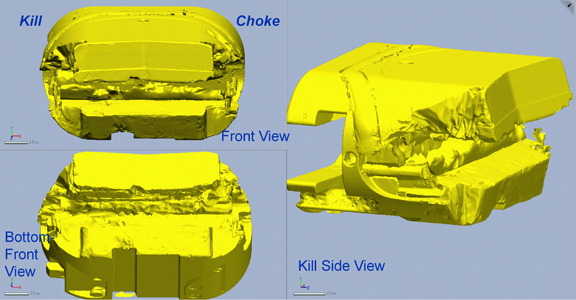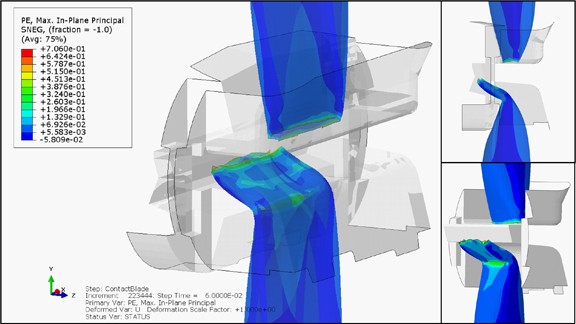Latest News
September 24, 2013
Call it an industrial detective story: The site is a floating oil rig, operating 40 miles off the southeast coast of Louisiana. The incident is an explosion, leading to an oil spill that unleashed about 4.9 million barrels of crude oil into Gulf of Mexico. (On Meet the Press, White House energy adviser Carol Browner called the incident “the biggest eco-disaster ever.”) The evidence collection involved raising the blowout preventer (BOP), along with recovered pieces of the drill pipe; transferring them to a holding facility; obtaining hydraulic fluid and metal samples; and laser-scanning the damaged blind-shear ram (BSR). The mystery: what happened?
The investigation team was DET NORSKE VERITAS (DNV), which won a contract from the Departments of Interior and Homeland Security to determine the performance and possible failure modes of the BOP stack. In their report published later, DNV listed the sequence of events as the disaster was unfolding:
Prior to the loss of well control on the evening of April 20, 2010, the UA (upper annular) was closed as part of a series of two negative or leak-off tests. Approximately 30 minutes after the conclusion of the second leak-off (negative pressure) test, fluids from the well began spilling onto the rig floor. At 21:47 the standpipe manifold pressure rapidly increased from 1200 psig to 5730 psig. The first explosion was noted as having occurred at 21:49. At 21:56 the EDS was noted to have been activated from the bridge. This was the final recorded well control attempt from the surface before the rig was abandoned at 22:28.
One of the key players was Shane Finneran, project engineer and team lead in DNV’s Computer Aided Engineering (CAE) Group in the Materials and Corrosion Technology Center in Dublin, Ohio. He and his colleagues turned to Abaqus FEA software (from SIMULIA, a Dassault Systèmes brand), which has been part of DNV’s investigative toolkit for over a decade.
FEA for Industrial Sleuths: Quite often aerospace and automotive manufacturers use FEA as a predictive tool —to use digital simulation to identify regions in their product where the thermal and stress loads might cause structural damage, for example. In other times, engineers also use FEA retroactively to reenact a physical event to better understand a phenomenon. The second usage anchors FEA as an ideal tool for the Deepwater Horizon investigation team to examine the BOP’s failure and identify probable causes.
“It would be extremely difficult and generally cost-prohibitive to run physical tests under the same conditions that exist two miles under the ocean, re-enacting a blowout scenario,” says Finneran. “Typical physical testing involves shearing pipe with no back pressure and no product flow. You’re proving that the blind shear ram can shear pipe and that the rams close properly. However, FEA can provide the means to perform extensive simulations of many types of damage—ranging from simplified deformation and buckling to post-buckling deformation and shearing—with realistic pressure and force measurements built into those simulations.”
Evidence and Simulation: By overlaying CAD models and digital models of the laser-scanned equipment fragments recovered from the seafloor and the site, the investigation team was able to clearly understand the extent of the damage and where most material losses occurred. They noted, for instance, that that “erosion occurred on both the top and bottom surfaces of the lower BSR blade. This erosion was particularly deep on the bottom surface on the kill-side of the blade and on the top surface on the choke-side on the blade.”
The team also digitally recreated the buckling of the drill pipe inside the wellbore—a buckling analysis—to determine what the necessary load would have been to move the pipe to the edge of the casing.
For the dynamic pipe shear models, the team used Abaqus Explicit code. In their report, DNV wrote, “The BSR is designed to fold the end of the lower pipe segment over to prevent damage to the lateral sealing element behind the upper blade as it passes across. Testing has shown that the lower piece can fracture at the fold point. The centered pipe shear analysis calculated a strain concentration of 32% along the inner bend, matching with the fracture area observed on physical tests.”
Findings and Recommendations: Discussing their conclusions on the causes, the DNV report’s authors noted, “The BSRs failed to fully close and seal due to a portion of drill pipe trapped between the blocks.” They also identified contributing causes, including the following:
- The BSRs were not able to move the entire pipe cross section completely into the shearing surfaces of the rams.
- Drill pipe in process of shearing was deformed outside the shearing blade surfaces.
- The drill pipe elastically buckled within the wellbore due to formation forces on loss of well control.
- the ability of the shear rams to complete their intended function of completely cutting tubulars regardless of their position within the wellbore, and sealing the well; and
- the potential effects or results that undertaking certain well control activities (e.g. closing of the annulars, or closing of the VBRs) could have on the BOP Stack.
According to Finneran, digital simulation driven by FEA is becoming an accepted forensic method to probe into industrial accidents. “Finite element analysis is frequently applied as an analytical simulation technique for engineering design, failure prediction, and post-failure analyses by both government and private entities. FEA is recommended as an acceptable numerical method within various industry accepted standards,” he said.
Read DNV’s announcement after the investigation here.
Are there industrial incidents you and your colleagues investigated using FEA? Please share your story in the comments.
Subscribe to our FREE magazine, FREE email newsletters or both!
Latest News
About the Author
Kenneth Wong is Digital Engineering’s resident blogger and senior editor. Email him at [email protected] or share your thoughts on this article at digitaleng.news/facebook.
Follow DERelated Topics








